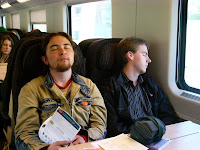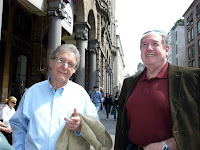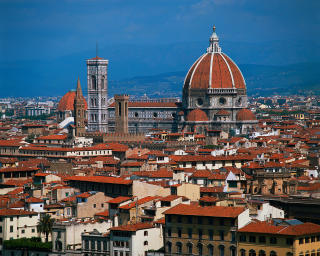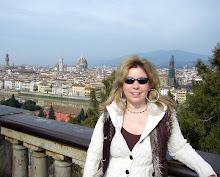 On April 12 I returned to Milan with another group of business students. This time is was a much larger group, all members of my International Business class. A total of 41 of us caught the 7:08 train to Milan, which proved to be pretty early for some of them!
On April 12 I returned to Milan with another group of business students. This time is was a much larger group, all members of my International Business class. A total of 41 of us caught the 7:08 train to Milan, which proved to be pretty early for some of them!
















 Once again the students used the three-hour train ride to do a variety of things. Some read while others played card. But the vast majority used that time to catch up on some much-needed sleep!
Once again the students used the three-hour train ride to do a variety of things. Some read while others played card. But the vast majority used that time to catch up on some much-needed sleep!We arrived in Milan around 10 a.m. and, just like last time, went immediately to the subway station to travel to the University of Milan. And, once again, Professor Gina Poncini and her colleagues and students proved to be the perfect hosts.
But this trip was much different from the last trip. That’s because this class didn’t have the anxiety of having to deliver presentations to a roomful of University of Milan students. Instead, this group was charged with simply exploring Milan, the financial and fashion capital of Italy. Not a bad assignment!








 After a brief orientation at the University of Milan, we all walked as a group to the Milan Cathedral, and then students dispersed from there, after a few pictures, of course! To help them out, they were given a handout with ideas for what to do and see. They were also given maps and cell phone numbers, just in case they got lost along the way. Here are the places that they were advised to visit:
After a brief orientation at the University of Milan, we all walked as a group to the Milan Cathedral, and then students dispersed from there, after a few pictures, of course! To help them out, they were given a handout with ideas for what to do and see. They were also given maps and cell phone numbers, just in case they got lost along the way. Here are the places that they were advised to visit:1. Piazza del Duomo and the Milan Duomo (Milan’s Cathedral)
2. Galleria Vittorio Emanuele II (an upscale shopping arcade and Milan’s “Drawing Room”)
3. Teatro alla Scala (world-famous opera house)
4. Palazzo Marino (home of Milan’s town hall since 1860)
5. Pinacoteca Ambrosiana (world-renowned art gallery)
6. Casa Manzoni (home where the author Alessandro Manzoni lived from 1814 until his death in 1873)
7. Castello Sforzesco and Parco Sempione (home to Milan’s civic museums)
8. Fiero di Milano (trade exhibition center)
9. Meazza (San Siro) Stadium (Milan’s football stadium)
10. Santa Maria delle Grazie (home of da Vinci’s Last Supper)
11. Piazza Affari and the Borso Valori (heart of Milan’s financial district and Italy’s most important stock exchange)
12. Museo Nazionale della Scienza e Tecnica (science and technology museum)
13. Fashion District (needs no explanation!)
And off they went!



 First on my agenda was lunch with Gina and my tour guide from my previous trip, Kim. Two of my students, Bruce and Jack, also joined us. The weather was gorgeous, spring flowers were everywhere, and it was a perfect day to eat al fresco. So Gina led us to a café on a pedestrian-only street that leads to the castle (more on that later). We had a wonderful lunch and great conversation at the Majestic Café.
First on my agenda was lunch with Gina and my tour guide from my previous trip, Kim. Two of my students, Bruce and Jack, also joined us. The weather was gorgeous, spring flowers were everywhere, and it was a perfect day to eat al fresco. So Gina led us to a café on a pedestrian-only street that leads to the castle (more on that later). We had a wonderful lunch and great conversation at the Majestic Café. While dining the peacefulness was frequently interrupted by sirens. One after another, police cars screamed down this pedestrian-only street. Where were they going? We could only speculate, which is pretty fun to do when you’re sitting with two San Francisco police officers. You see, Jack is an active SF police officer and Bruce is retired from the force. Their final theory was that the captain had ordered a pizza for lunch at wanted to make sure that it arrived hot!
While dining the peacefulness was frequently interrupted by sirens. One after another, police cars screamed down this pedestrian-only street. Where were they going? We could only speculate, which is pretty fun to do when you’re sitting with two San Francisco police officers. You see, Jack is an active SF police officer and Bruce is retired from the force. Their final theory was that the captain had ordered a pizza for lunch at wanted to make sure that it arrived hot!What we learned later is that the police cars were racing to a disturbance in Chinatown. Here’s what Gina was able to find out later: “Apparently city regulations about loading and unloading (and therefore parked trucks etc.) hadn't been enforced for about 10 years, while the number of wholesalers and storage services in the residential district kept growing along with ‘illegal’ businesses (workers with no permits). Nothing had been done over the years, it seems, despite complaints of long-time (i.e., non-Chinese) residents. Over the last few months the city started to enforce regulations (giving fines when regulations were broken), and it continued with plans to make a pedestrian area, so tension grew and the Chinese businesses perceived the ‘crackdown’ as aimed just at their community.” This resulted in a demonstration involving approximately 300 Chinese protestors, during which about 15 people were injured, most of them police officers.
A little excitement to start our day in Milan!

 After lunch Gina and Kim had to return to work, and Bruce and Jack set off to explore the city. I knew exactly where I was going first: Castello Sforzesco.
After lunch Gina and Kim had to return to work, and Bruce and Jack set off to explore the city. I knew exactly where I was going first: Castello Sforzesco.


 This beautiful castle was originally built in 1368 as a fortress. It later served as a ducal palace, a court, and military offices. Today it is home to the Civic Museums, containing one of the largest collections of art in Milan. There are separate museums devoted to ancient art, paintings, the Egyptians, prehistory and proto-history, decorative arts, furniture, musical instruments, prints, photography, and archeology. The castle is huge and could take all day (or two!) to explore, so I visited just a few sections.
This beautiful castle was originally built in 1368 as a fortress. It later served as a ducal palace, a court, and military offices. Today it is home to the Civic Museums, containing one of the largest collections of art in Milan. There are separate museums devoted to ancient art, paintings, the Egyptians, prehistory and proto-history, decorative arts, furniture, musical instruments, prints, photography, and archeology. The castle is huge and could take all day (or two!) to explore, so I visited just a few sections. First I went to the section devoted to ancient art. This collection of approximately 2,000 pieces is amazing! Of particular interest is Room VIII (Sala delle Asse), which is a completely frescoed room believed to have been done by Leonardo da Vinci.
First I went to the section devoted to ancient art. This collection of approximately 2,000 pieces is amazing! Of particular interest is Room VIII (Sala delle Asse), which is a completely frescoed room believed to have been done by Leonardo da Vinci. I was also excited to discover, upon entering Room XIV (Sala Verde), the 15th-century Portal of the Medici Bank (my International Business class has been studying the Medici extensively). This portal originally formed part of the main entrance to Palazzo Medici in Milan, where the Milan branch of the Medici bank was located.
I was also excited to discover, upon entering Room XIV (Sala Verde), the 15th-century Portal of the Medici Bank (my International Business class has been studying the Medici extensively). This portal originally formed part of the main entrance to Palazzo Medici in Milan, where the Milan branch of the Medici bank was located.
 But the most important work in the entire collection, in my mind, is the Rondanini Pietà by Michelangelo. This moving piece is believed to have been the last one created by Michelangelo. In fact, he was still working on it days before he died on February 18, 1564. I love the fact that it’s unfinished; in fact, only the calves appear to be anywhere near done. The rest of the piece is rough, allowing us to see the chisel marks actually made by Michelangelo’s hands. To me this is so much more beautiful than his completed and polished pieces (such as David) because it feels more real—you actually feel closer to the artist with a piece like this.
But the most important work in the entire collection, in my mind, is the Rondanini Pietà by Michelangelo. This moving piece is believed to have been the last one created by Michelangelo. In fact, he was still working on it days before he died on February 18, 1564. I love the fact that it’s unfinished; in fact, only the calves appear to be anywhere near done. The rest of the piece is rough, allowing us to see the chisel marks actually made by Michelangelo’s hands. To me this is so much more beautiful than his completed and polished pieces (such as David) because it feels more real—you actually feel closer to the artist with a piece like this.
 After admiring this collection, and spending a lot of time with the Pietà, I visited both the paintings (over 1,500 works of art by artists such as Filippo Lippi, Giovanni Bellini, Tiziano, and Tintoretto) and furniture (featuring six centuries of designs) galleries. Then I searched until I found the section devoted to musical instruments. This is the second-largest instrument collection in Italy and one of the most important in all of Europe. Here I enjoyed seeing gorgeous violins, violas, cellos, guitars, spinets, harpsichords, pianos, and brass instruments. The only thing missing was actual music! The exhibit could be greatly enhanced with the inclusion of classical music. Oh well!
After admiring this collection, and spending a lot of time with the Pietà, I visited both the paintings (over 1,500 works of art by artists such as Filippo Lippi, Giovanni Bellini, Tiziano, and Tintoretto) and furniture (featuring six centuries of designs) galleries. Then I searched until I found the section devoted to musical instruments. This is the second-largest instrument collection in Italy and one of the most important in all of Europe. Here I enjoyed seeing gorgeous violins, violas, cellos, guitars, spinets, harpsichords, pianos, and brass instruments. The only thing missing was actual music! The exhibit could be greatly enhanced with the inclusion of classical music. Oh well!

 Well, I had been indoors enough, and the day was as gorgeous one, so I walked out of the castle and directly into Parco Sempione, which sits right behind the castle. This is a 116-acre park filled with grass, trees, English-style gardens, fountains, sculptures, and monuments. While walking out to the part, I ran into a group of our students, also looking forward to a little time in the sunshine!
Well, I had been indoors enough, and the day was as gorgeous one, so I walked out of the castle and directly into Parco Sempione, which sits right behind the castle. This is a 116-acre park filled with grass, trees, English-style gardens, fountains, sculptures, and monuments. While walking out to the part, I ran into a group of our students, also looking forward to a little time in the sunshine!

 After enjoying the sunshine and green grass, I walked back down the pedestrian-only street, which had a wonderful photography exhibit about countries that produce coffee up and down the sidewalks, toward the financial district.
After enjoying the sunshine and green grass, I walked back down the pedestrian-only street, which had a wonderful photography exhibit about countries that produce coffee up and down the sidewalks, toward the financial district.

 Milan’s financial district is built around Piazza Affari, which sits at the heart of the district. The piazza itself was originally laid out between 1928 and 1940 to house the city’s produce markets. Today the piazza is lined with important buildings, including the Borsa Valori (Italy’s most important stock exchange) and the Italian Telecom building with its wonderful Art Deco relief.
Milan’s financial district is built around Piazza Affari, which sits at the heart of the district. The piazza itself was originally laid out between 1928 and 1940 to house the city’s produce markets. Today the piazza is lined with important buildings, including the Borsa Valori (Italy’s most important stock exchange) and the Italian Telecom building with its wonderful Art Deco relief.




 Other interesting buildings in the financial district include Banca Italia, the Poste, and many others. What I found surprising, though, was how few people were out in this district on a weekday afternoon. Perhaps they were all hard at work in these beautiful buildings, but there was none of the excitement and hustle and bustle that you would find in the financial districts of, say, New York or San Francisco. I almost found the deserted streets a little eerie!
Other interesting buildings in the financial district include Banca Italia, the Poste, and many others. What I found surprising, though, was how few people were out in this district on a weekday afternoon. Perhaps they were all hard at work in these beautiful buildings, but there was none of the excitement and hustle and bustle that you would find in the financial districts of, say, New York or San Francisco. I almost found the deserted streets a little eerie! After exploring the financial district, I walked back toward the Cathedral so that I could walk through Galleria Vittorio Emanuele II (Milan’s “Drawing Room”). This elegant shopping arcade, which was built in 1867, is lined with upscale shops and restaurants. But most impressive is the structure itself, complete with its floor mosaics representing geographical areas (Europe, Asia, Africa, and the U.S.), fields (science, industry, art, and agriculture, and the major Italian cities
After exploring the financial district, I walked back toward the Cathedral so that I could walk through Galleria Vittorio Emanuele II (Milan’s “Drawing Room”). This elegant shopping arcade, which was built in 1867, is lined with upscale shops and restaurants. But most impressive is the structure itself, complete with its floor mosaics representing geographical areas (Europe, Asia, Africa, and the U.S.), fields (science, industry, art, and agriculture, and the major Italian cities  (the bull of Turin, the wolf of Rome, the lily of Florence, and the red cross of Milan). So which mosaic is the most famous of all? Well, it’s the Turin bull. Legend has it that if you spin your heels on the “private parts” of the bull, you’ll be rewarded with good luck. So here I am showing you how it’s done! Notice how this part of the bull has worn away from all that heel spinning over the years.
(the bull of Turin, the wolf of Rome, the lily of Florence, and the red cross of Milan). So which mosaic is the most famous of all? Well, it’s the Turin bull. Legend has it that if you spin your heels on the “private parts” of the bull, you’ll be rewarded with good luck. So here I am showing you how it’s done! Notice how this part of the bull has worn away from all that heel spinning over the years. I walked through the galleria, coming out at Palazzo Marino, home to Milan’s town hall since 1860. A statue of Leonardo da Vinci sits proudly at the center of this square.
I walked through the galleria, coming out at Palazzo Marino, home to Milan’s town hall since 1860. A statue of Leonardo da Vinci sits proudly at the center of this square.
 One thing I especially loved seeing while walking through Milan were the streets named for famous Italians. Here are just two: Giuseppe Verdi and Alessandro Manzoni. Each street sign tells you not only the street name, but it also gives information about who these people are and what their contributions were. More cities should do this!
One thing I especially loved seeing while walking through Milan were the streets named for famous Italians. Here are just two: Giuseppe Verdi and Alessandro Manzoni. Each street sign tells you not only the street name, but it also gives information about who these people are and what their contributions were. More cities should do this!



 Finally I reached the fashion center of Milan, what many consider to be the fashion capital of the world. Although many streets make up this world-famous area, Via Montenapoleone is really the “main drag.”It is here that you'll find all of those famous Italian designers, including Salvatore Ferragamo, Valentino, Armani, Bulgari, and many others. Although what's sold in this store is well beyond my budget, it was still fun to look.
Finally I reached the fashion center of Milan, what many consider to be the fashion capital of the world. Although many streets make up this world-famous area, Via Montenapoleone is really the “main drag.”It is here that you'll find all of those famous Italian designers, including Salvatore Ferragamo, Valentino, Armani, Bulgari, and many others. Although what's sold in this store is well beyond my budget, it was still fun to look.
 However, I couldn't look for long as it was time to return to the University of Milan, where we had agree to meet at 5:15. Everyone showed up on time, and for good reason. It was time for aperitivo! We gathered up the belongings we had all stored on campus, and somehow Gillian got put in charge of coat duty. (Great work, Gillian!)
However, I couldn't look for long as it was time to return to the University of Milan, where we had agree to meet at 5:15. Everyone showed up on time, and for good reason. It was time for aperitivo! We gathered up the belongings we had all stored on campus, and somehow Gillian got put in charge of coat duty. (Great work, Gillian!)













 We then walked down the street to a bar where Gina had mad reservations for us. We were given an entire part of the outside patio, which was very nice. And the cost of a drink also included a buffet of various appetizers, including pastas, pizza, vegetables, foccacia, and other goodies.
We then walked down the street to a bar where Gina had mad reservations for us. We were given an entire part of the outside patio, which was very nice. And the cost of a drink also included a buffet of various appetizers, including pastas, pizza, vegetables, foccacia, and other goodies.
 Once everyone's drinks had arrived, we made a toast to Gina to thank her and her students for their wonderful hospitality. We also wished her happy birthday and presented her with a bouquet of beautiful yellow tulips. Yes, Gina chose to spend her birthday with all of us!
Once everyone's drinks had arrived, we made a toast to Gina to thank her and her students for their wonderful hospitality. We also wished her happy birthday and presented her with a bouquet of beautiful yellow tulips. Yes, Gina chose to spend her birthday with all of us!
 Too soon, though, it was time to board a train back to Florence. We said our goodbyes, and a few students chose to stay overnight in Milan. But most of us caught the 8 p.m. train, which got us back to Florence at around 11 p.m. These final shots are at the San Babila subway station. Jonathan's stretching says it all. It was the end of a tiring but very full and exciting day in Milan.
Too soon, though, it was time to board a train back to Florence. We said our goodbyes, and a few students chose to stay overnight in Milan. But most of us caught the 8 p.m. train, which got us back to Florence at around 11 p.m. These final shots are at the San Babila subway station. Jonathan's stretching says it all. It was the end of a tiring but very full and exciting day in Milan.


No comments:
Post a Comment